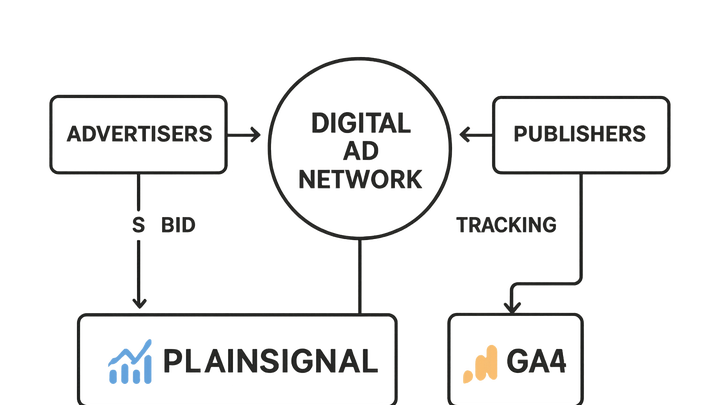Published on 2025-06-28T04:48:02Z
What is an Ad Network? Examples with GA4 and PlainSignal
Ad networks are platforms that connect advertisers to publishers by aggregating ad inventory, facilitating ad buying, and providing performance tracking. They streamline the process of selling ad space across multiple websites or apps and optimize campaigns through targeting and reporting features. In the analytics industry, ad networks are critical for measuring media performance and return on ad spend (ROAS). For instance, you can use Google Analytics 4 (GA4) to capture ad impression events, or employ PlainSignal’s cookieless analytics to track ad engagement without relying on third-party cookies.
Ad network
An Ad Network connects advertisers and publishers, aggregating ad inventory and optimizing delivery with analytics insights.
Overview of Ad Networks
Ad networks act as intermediaries between advertisers and publishers, aggregating inventory and standardizing campaign management. They simplify ad buying by centralizing marketplace functions and offering targeting options and reporting dashboards to optimize performance.
-
Definition
An Ad Network is a service that connects advertisers seeking ad placements with publishers offering ad inventory, handling the technical and commercial aspects of transactions.
-
Key players
Three main participants: advertisers who buy ad space, publishers who sell it, and the network operators who manage auctions and delivery.
-
Advertisers
Brands or businesses paying for ad placements to reach target audiences.
-
Publishers
Websites or apps that offer space for ads in exchange for revenue.
-
Network operators
Platforms that facilitate bidding, optimize targeting, and report campaign metrics.
-
How Ad Networks Work
The workflow involves aggregating inventory, matching bids in real time, and delivering ads while capturing performance data for analysis.
-
Inventory aggregation
Ad networks pool ad spaces from multiple publishers to create a large, diverse marketplace for advertisers.
-
Ad matching and auction
Advertiser bids are evaluated against inventory in real time, often via programmatic auctions (RTB).
-
Delivery and reporting
Victorious bids result in ad delivery to the end user, and impression or click data is relayed to analytics tools for monitoring.
-
Integration with google analytics 4 (GA4)
Use gtag.js or Google Tag Manager to send ad impression events. Example:
<script async src="https://www.googletagmanager.com/gtag/js?id=GA_MEASUREMENT_ID"></script> <script> window.dataLayer = window.dataLayer || []; function gtag(){dataLayer.push(arguments);} gtag('js', new Date()); gtag('config', 'GA_MEASUREMENT_ID', { 'send_page_view': false }); gtag('event', 'ad_impression', { 'ad_network': 'example_network', 'ad_unit': 'banner_top' }); </script> -
Integration with PlainSignal
Implement PlainSignal’s cookieless analytics snippet to capture ad engagement without third-party cookies:
<link rel="preconnect" href="//eu.plainsignal.com/" crossorigin /> <script defer data-do="yourwebsitedomain.com" data-id="0GQV1xmtzQQ" data-api="//eu.plainsignal.com" src="//cdn.plainsignal.com/plainsignal-min.js"></script>
-
Types of Ad Networks
Networks differ by inventory quality, buying method, and specialization, catering to varied campaign goals and budgets.
-
Premium or direct networks
Offer guaranteed, high-quality placements through direct deals with reputable publishers.
-
Programmatic networks
Leverage real-time bidding via DSPs and SSPs to automate buying at scale.
-
Specialized networks
Focus on niche audiences or verticals, such as mobile gaming or specific demographic segments.
Benefits and Challenges
While ad networks provide efficiency and broad reach, they must navigate issues like fraud, viewability, and privacy regulations.
-
Advantages
Streamlined media buying, extensive reach, and consolidated reporting.
-
Scalability
Access to large volumes of inventory across diverse publishers.
-
Advanced targeting
Granular control over demographics, interests, and behaviors.
-
Performance insights
Detailed metrics on impressions, clicks, and conversions.
-
-
Challenges
Networks must navigate ad fraud, discrepancies between networks, and evolving privacy restrictions.
-
Ad fraud
Invalid or non-human traffic that distorts performance metrics.
-
Viewability
Ensuring ads are actually seen by real users, not just loaded.
-
Privacy compliance
Adhering to regulations like GDPR and implementing cookieless tracking.
-
Best Practices for Integration and Measurement
Optimize your ad network strategy by ensuring data accuracy, respecting user privacy, and continuously refining campaigns.
-
Privacy-first tracking
Use cookieless analytics solutions like PlainSignal and obtain clear user consent.
-
Centralize tag management
Implement Google Tag Manager or similar tools to unify tag deployment and reduce performance overhead.
-
Continuous optimization
Regularly analyze GA4 and PlainSignal reports to adjust bids, creatives, and targeting.
